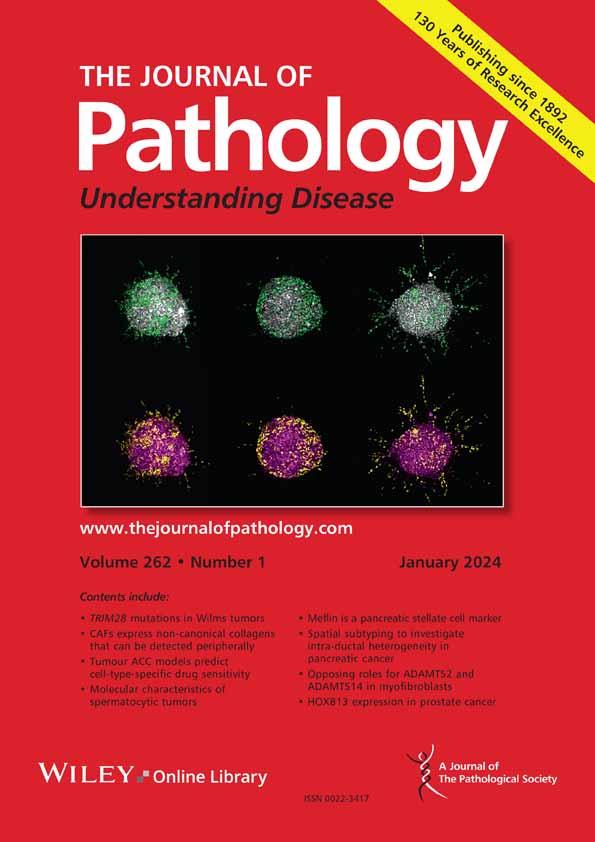Antonio Pea, Michele Bevere, Anastasios Gkountakos, Davide Pasini, Denise Fiorini, Andrea Mafficini, Stela Golovco, Michele Simbolo, Serena Pedron, Concetta Sciammarella, Paola Mattiolo, Aldo Mombello, Manuela Villanova, Carlotta Franzina, Francesca Masetto, Calogero Ciulla, Nicola Sperandio, Kohei Fujikura, Masha S. Ahadi, Jaswinder S. Samra, Amber L. Johns, Joanne Verheij, Martijn W.J. Stommel, Hjalmar van Santvoort, Leonor Schubert Santana, Giuseppe Malleo, Michele Milella, Lodewijk A. A. Brosens, Laura D. Wood, David K. Chang, Riccardo De Robertis, Mirko D'Onofrio, Anthony J. Gill, Roberto Salvia, Vincenzo Corbo, Rita T. Lawlor, Aldo Scarpa, Claudio Luchini
下载PDF
{"title":"粘液囊性肿瘤和单纯性粘液囊肿是胰腺癌的两种不同的前体:临床病理学、基因组学和转录组学特征。","authors":"Antonio Pea, Michele Bevere, Anastasios Gkountakos, Davide Pasini, Denise Fiorini, Andrea Mafficini, Stela Golovco, Michele Simbolo, Serena Pedron, Concetta Sciammarella, Paola Mattiolo, Aldo Mombello, Manuela Villanova, Carlotta Franzina, Francesca Masetto, Calogero Ciulla, Nicola Sperandio, Kohei Fujikura, Masha S. Ahadi, Jaswinder S. Samra, Amber L. Johns, Joanne Verheij, Martijn W.J. Stommel, Hjalmar van Santvoort, Leonor Schubert Santana, Giuseppe Malleo, Michele Milella, Lodewijk A. A. Brosens, Laura D. Wood, David K. Chang, Riccardo De Robertis, Mirko D'Onofrio, Anthony J. Gill, Roberto Salvia, Vincenzo Corbo, Rita T. Lawlor, Aldo Scarpa, Claudio Luchini","doi":"10.1002/path.6437","DOIUrl":null,"url":null,"abstract":"<p>Mucinous cystic neoplasms (MCNs) of the pancreas are macroscopic precursors of pancreatic cancer. A similar cystic lesion but lacking the ovarian-type subepithelial stroma has been recently defined as a simple mucinous cyst (SMC); however, its nature remains unclear. This study aims to define the clinicopathological and molecular profiles of a cohort of MCNs and SMCs of the pancreas and their associated invasive carcinoma. Overall, 23 cases were identified, comprising 19 MCNs and 4 SMCs with co-occurring invasive carcinoma. A multiregional (two samples from each cystic lesion and one from the adenocarcinoma) DNA and RNA sequencing approach was used. The key findings can be summarized as follows: (1) Molecular association: In 22/23 cases (95.7%), the concomitant mucinous cyst and invasive carcinoma shared specific genomic alterations, establishing for the first time that SMC is a true precursor of pancreatic cancer. (2) Clinical behavior: carcinomas arising from SMC appeared to be more aggressive than those arising from MCN. (3) Mutational profile: both cyst types showed significant similarities to conventional pancreatic ductal adenocarcinoma (PDAC), with <i>KRAS</i> and <i>TP53</i> the most commonly altered genes. (4) Intracystic heterogeneity: while most molecular alterations were present in both analyzed cystic areas, <i>RNF43</i> showed the highest heterogeneity. (5) <i>CDKN2A</i>: its alterations were predominantly restricted to the invasive component, suggesting a role in driving the invasion in a subset of cases. <i>CNKN2A</i> may also serve as a potential biomarker for identifying high-risk cysts. (6) RNAseq: most cases showed a switch from the classical to the basal transcriptome subtype during the progression from cystic neoplasms to invasive cancers. These findings establish SMCs as new precursors of pancreatic cancer and provide critical insights into the tumorigenesis of MCNs, with potential immediate implications for tumor taxonomy and clinical management. © 2025 The Author(s). <i>The Journal of Pathology</i> published by John Wiley & Sons Ltd on behalf of The Pathological Society of Great Britain and Ireland.</p>","PeriodicalId":232,"journal":{"name":"The Journal of Pathology","volume":"266 4-5","pages":"421-434"},"PeriodicalIF":5.2000,"publicationDate":"2025-05-15","publicationTypes":"Journal Article","fieldsOfStudy":null,"isOpenAccess":false,"openAccessPdf":"https://onlinelibrary.wiley.com/doi/epdf/10.1002/path.6437","citationCount":"0","resultStr":"{\"title\":\"Mucinous cystic neoplasms and simple mucinous cysts are two distinct precursors of pancreatic cancer: clinicopathological, genomic, and transcriptomic characterization\",\"authors\":\"Antonio Pea, Michele Bevere, Anastasios Gkountakos, Davide Pasini, Denise Fiorini, Andrea Mafficini, Stela Golovco, Michele Simbolo, Serena Pedron, Concetta Sciammarella, Paola Mattiolo, Aldo Mombello, Manuela Villanova, Carlotta Franzina, Francesca Masetto, Calogero Ciulla, Nicola Sperandio, Kohei Fujikura, Masha S. Ahadi, Jaswinder S. Samra, Amber L. Johns, Joanne Verheij, Martijn W.J. Stommel, Hjalmar van Santvoort, Leonor Schubert Santana, Giuseppe Malleo, Michele Milella, Lodewijk A. A. Brosens, Laura D. Wood, David K. Chang, Riccardo De Robertis, Mirko D'Onofrio, Anthony J. Gill, Roberto Salvia, Vincenzo Corbo, Rita T. Lawlor, Aldo Scarpa, Claudio Luchini\",\"doi\":\"10.1002/path.6437\",\"DOIUrl\":null,\"url\":null,\"abstract\":\"<p>Mucinous cystic neoplasms (MCNs) of the pancreas are macroscopic precursors of pancreatic cancer. A similar cystic lesion but lacking the ovarian-type subepithelial stroma has been recently defined as a simple mucinous cyst (SMC); however, its nature remains unclear. This study aims to define the clinicopathological and molecular profiles of a cohort of MCNs and SMCs of the pancreas and their associated invasive carcinoma. Overall, 23 cases were identified, comprising 19 MCNs and 4 SMCs with co-occurring invasive carcinoma. A multiregional (two samples from each cystic lesion and one from the adenocarcinoma) DNA and RNA sequencing approach was used. The key findings can be summarized as follows: (1) Molecular association: In 22/23 cases (95.7%), the concomitant mucinous cyst and invasive carcinoma shared specific genomic alterations, establishing for the first time that SMC is a true precursor of pancreatic cancer. (2) Clinical behavior: carcinomas arising from SMC appeared to be more aggressive than those arising from MCN. (3) Mutational profile: both cyst types showed significant similarities to conventional pancreatic ductal adenocarcinoma (PDAC), with <i>KRAS</i> and <i>TP53</i> the most commonly altered genes. (4) Intracystic heterogeneity: while most molecular alterations were present in both analyzed cystic areas, <i>RNF43</i> showed the highest heterogeneity. (5) <i>CDKN2A</i>: its alterations were predominantly restricted to the invasive component, suggesting a role in driving the invasion in a subset of cases. <i>CNKN2A</i> may also serve as a potential biomarker for identifying high-risk cysts. (6) RNAseq: most cases showed a switch from the classical to the basal transcriptome subtype during the progression from cystic neoplasms to invasive cancers. These findings establish SMCs as new precursors of pancreatic cancer and provide critical insights into the tumorigenesis of MCNs, with potential immediate implications for tumor taxonomy and clinical management. © 2025 The Author(s). <i>The Journal of Pathology</i> published by John Wiley & Sons Ltd on behalf of The Pathological Society of Great Britain and Ireland.</p>\",\"PeriodicalId\":232,\"journal\":{\"name\":\"The Journal of Pathology\",\"volume\":\"266 4-5\",\"pages\":\"421-434\"},\"PeriodicalIF\":5.2000,\"publicationDate\":\"2025-05-15\",\"publicationTypes\":\"Journal Article\",\"fieldsOfStudy\":null,\"isOpenAccess\":false,\"openAccessPdf\":\"https://onlinelibrary.wiley.com/doi/epdf/10.1002/path.6437\",\"citationCount\":\"0\",\"resultStr\":null,\"platform\":\"Semanticscholar\",\"paperid\":null,\"PeriodicalName\":\"The Journal of Pathology\",\"FirstCategoryId\":\"3\",\"ListUrlMain\":\"https://pathsocjournals.onlinelibrary.wiley.com/doi/10.1002/path.6437\",\"RegionNum\":2,\"RegionCategory\":\"医学\",\"ArticlePicture\":[],\"TitleCN\":null,\"AbstractTextCN\":null,\"PMCID\":null,\"EPubDate\":\"\",\"PubModel\":\"\",\"JCR\":\"Q1\",\"JCRName\":\"ONCOLOGY\",\"Score\":null,\"Total\":0}","platform":"Semanticscholar","paperid":null,"PeriodicalName":"The Journal of Pathology","FirstCategoryId":"3","ListUrlMain":"https://pathsocjournals.onlinelibrary.wiley.com/doi/10.1002/path.6437","RegionNum":2,"RegionCategory":"医学","ArticlePicture":[],"TitleCN":null,"AbstractTextCN":null,"PMCID":null,"EPubDate":"","PubModel":"","JCR":"Q1","JCRName":"ONCOLOGY","Score":null,"Total":0}
引用次数: 0
引用
批量引用




 求助内容:
求助内容: 应助结果提醒方式:
应助结果提醒方式:


